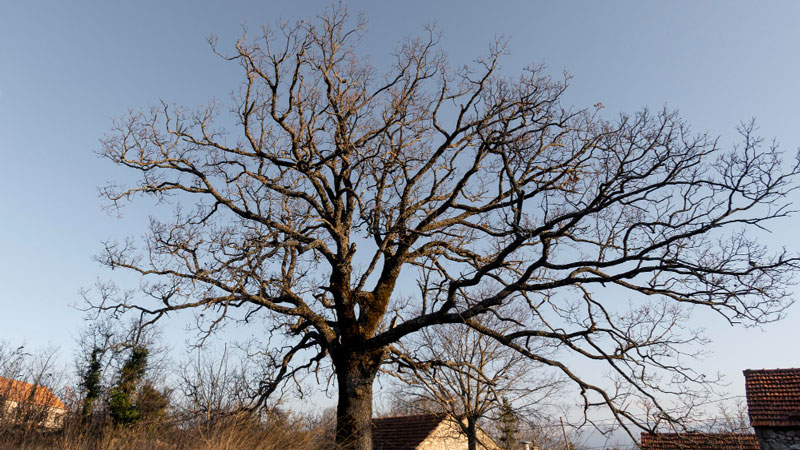Why Does My Apple Tree Have No Leaves? (Common Causes)

Growing your own apples is an experience everyone should have. That crunch of an apple you’ve picked from your own yard is like nothing else. Like many plants and trees, your apple tree is susceptible to illness and disease. It may lose all of its leaves, or it may simply stop producing leaves.
Learning how to best care for your in-distress tree can help to keep it healthy for years to come. But just where do you start? How do you figure out what’s wrong with a tree?
The good news is that you don’t need an advanced degree. Learning what’s wrong with a tree or any plant is basic science and good common sense.
We’ve gathered the five approaches you can take to determine what is wrong with your tree.
Detecting What’s Wrong With Your Apple Tree
1. How Old Is The Tree?
Your apple tree may just be old. While apple trees can live for decades, ones that didn’t get a healthy start to life may not fare as well. If the tree simply seems to be old, it may be time to have it removed.
Is there any new growth on the tree? When last did you see growth from the tree?
If it has been a year or two since the tree has grown, shown new life or had leaves, then it might be time to call it on the tree.
What We Love About This Solution:
While no one likes to lose a tree, removing an old, dead tree will make way for a new tree. You’ll be able to plant another apple tree, or perhaps a plum. New starts can be wonderful, particularly when it comes to gardening.
2. Examine The Root System; The Roots May Have Been Damaged
Even the strongest of trees can suffer from root disruption. Perhaps you have dug around the garden and damaged the roots? Perhaps a utility company has dug and damaged the roots? Root damage is not always reversible. Determine the extent of the damage to the roots. If it is minor, then you may be able to treat the tree.
Ensure that there is plenty of loose soil around the roots. Add a diluted fertilizer product and ensure that the tree is well watered. You may not see results until next spring, but don’t despair. If the tree is allowed to recover, it will.
If the damage is too extensive, you may need to remove the tree.
What We Love About This Solution:
It’s relatively easy to check on the health of your tree’s roots. This is a quick step you can take when diagnosing your tree. Healthy roots are essential for any plant or tree. Keeping an eye on your tree’s roots can assure you of a tree that lasts for many more years.
3. Is The Tree Getting Enough Water?
The water needs of your tree can change with the seasons. A tree that is not getting enough water will lose its leaves. During the summer months, the roots may dry out. You may want to water the tree a bit at night. Waiting until night will ensure that the water goes to the roots and doesn’t evaporate.
A tree full of fruit will definitely need more water. So be mindful of the season and how much fruit the tree is growing.
What We Love About This Solution:
For something easy and quick, watering your tree can quickly resolve the issue for you.
4. Recognizing Fungal Infections
There are several fungal diseases that can have an impact on apples. These could include powdery mildew, oak root fungus, apple scab, and sappy bark. Examining the tree and learning to identify the fungal infections it may have can help you learn how to treat it.
These infections can take hold of the tree and lead to leaves falling off. Apple scab, in particular, can cause significant damage to an apple tree. It may take a growing season or two for the tree to fully recover.
Keep in mind that if you have more than one apple tree, you will need to treat them all.
What We Love About This Solution:
Fungal infections can be severe, but they can also be readily resolved. The important thing is to find the infection early enough so that treatment works.
If A Tree Has No Leaves, Is It Dead?
You shouldn’t panic when a tree has shed all of its leaves. Some trees, particularly deciduous trees, do this on a seasonal basis to conserve resources. Some plants lose all their leaves to protect themselves from pests or harsh weather.
In rare situations, a disease that is easily treated may be to blame for the tree’s lack of leaves. This does not, however, imply that all cases of a tree’s lack of leaves are recoverable. A tree losing its leaves may be an indication that the tree is dying. Even with your best efforts, you may not be able to save the tree in this situation.
What Is The Best Solution When An Apple Tree Has No Leaves?
The best solution for your apple tree is the one that addresses the exact reason for the leaves falling. Keep in mind that some trees do drop their leaves early as a part of their normal life cycle. If there is an infection, you must address the infection quickly.